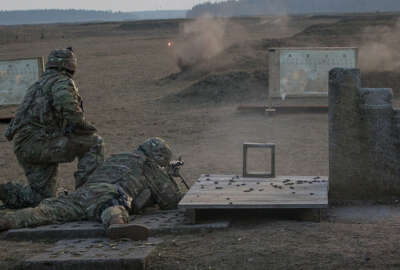As the military continues to change its posture to focus more on Russia and China, the Army announced its plans for the next 10 years to fit the Defense Department’s new stance.
Most of the service’s goals for 2028 come as no surprise, considering Army officials have already been pushing for many of the plan’s tenets.
However, this is the first time the Army compiled and codified its strategy for new rivals and for the future.
“The Army of 2028 will be able to deploy, fight and win decisively against any adversary, anytime and anywhere in a joint, multi-domain, high-intensity conflict while simultaneously deterring others and maintaining its ability to conduct irregular warfare,” Army Secretary Mark Esper said June 5 during a speech at the Brookings Institution in Washington.
In simpler terms, the military and the Army want to be able to win in land, air, sea, space and cyberspace against powerful countries with intense fighting while still being able to knock off terrorists and conduct special operations.
Doing that is a big and expensive task, which involves ramping up the Army’s size and capabilities until 2022.
Esper said the Army will need to increase its active-duty force to more than 500,000 and grow the Reserve and National Guard.
The Army started this part of the plan already; it is growing its force by 7,600.
The Army is also toying with the idea of increasing its basic training to 21 weeks to focus on improving fitness. The service is currently experimenting with a 21 week course at Ft. Benning, and Georgia and plans to expand it to certain one station unit training courses in the future. The Army has the highest number of nondeployable troops of any service due to obesity. The extra training will also help keep talented individuals who are not as active in better shape.
“This generation has an incredible facility with electronics, with software and all that,” Esper said. “On the other hand they may not be coming in as physically fit as previous generations for one reason or another. That’s one reason we’re looking at an extended basic training.”
Esper added the training will also increase the readiness and lethality of the total force. The Army is preparing its soldiers to fight in new areas, particularly in high-intensity conflict in urban areas with electronically degraded environments.
The lack of or jamming of electronic devices puts an emphasis on leadership, another tenet in the Army’s plan and something Army Chief of Staff Gen. Mark Milley pointed out more than two years ago.
“We still practice centralized, top-down, orders-driven type operations. I don’t think that method of training our soldiers will prevail in a future conflict against a near-peer competitor,” Milley said in late 2015. “Our leaders then are going to have to be self-starters. They are going to have to have maximum amounts of initiative. They are going to have to have critical thinking skills well beyond what we normally think of today in our operations. They are going to have to have huge amounts of character so that they make the right moral and ethical choices with the absence of supervision under the intense pressure of combat. They are going to have to have a level of mental and organizational agility that is not necessarily current in any army really.”
The Army’s new plan doubles down on DoD’s current push for an increase in drones both in the ground and the air, as well as man-machine coordination, artificial intelligence and robotics.
The Army is already in the works of setting up its Futures Command, which will decide what city to locate to by June 30.
Futures Command is the biggest acquisition revamp of the service in the past 40 years.
Officials say they want soldiers to be involved in the acquisition process from beginning to end, the theory being that previous efforts have asked for feedback from end users far too late in the acquisition process, prompting changes that are difficult and expensive to make once a system has progressed too far into its development lifecycle.
“With a few exceptions, what we have is essentially a linear process — going from an idea, writing up a big requirements document and then vetting it through multiple steps — it takes years, and it’s just not going to be effective going into the future,” Gen. Mark Milley, the Army’s chief of staff, told reporters. “So we’re going to re-engineer the corporation.”
The command and the Army as a whole are focusing on six lines of effort to modernize including future vertical life, networks and long-range precision weapons.
Esper said long-range precision weapons are the top priority right now.
Earlier this year, Milley said he wanted guns that can shoot much farther than they can now.
“Our Army here today and our military emphasizes, accentuates and uses precision fires to a great extent. We in the Army have a major part in that. We already have relatively good long range fires. But I’m not talking about the ranges that currently exist today. I’m talking about a 10 times capability for ground forces to really reach out and touch not with missiles, but with bullets,” Milley said.
Copyright
© 2024 Federal News Network. All rights reserved. This website is not intended for users located within the European Economic Area.
